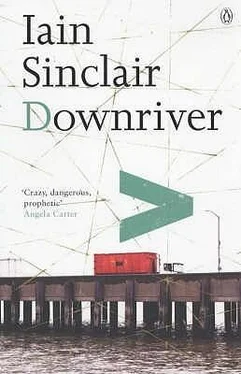The two travellers in whom Tenniel does feign an interest are ‘the gentleman opposite’ and the Goat. The gentleman (described in the text as being ‘dressed in white paper’) is depicted in a perfectly proper white suit, a Suez Canal speculator. He ghosts the popular Punch-icon of Disraeli; civilized, worldly, Semitic, with a wisp of beard — kissing cousin to the Goat. His hat is a folded triangle of paper; a pyramid, a toy imperial yacht. The words ‘white paper’ perhaps gave Tenniel the executive hint he elevated into a full-blown caricature. His oily nabob leers disagreeably over the top of his journal, which is innocent of print — an obvious voyeur’s trick, these folded blank sheets disguise something peculiar and repellent, artichoke-leaved, that is emerging from the Gentleman’s waistcoat pocket. His unequivocal designs on Alice will supply the missing headlines for the scandal sheet: in this case, certainly, no news is good news.
The Goat bides his time, masking his folklore attributes in a show of sleep. These dreams are better left unvisited. But the position of the Gentleman’s crossed leg, with bulky folds of material at the knee, supplies the Goat with a mythically engorged member. He has been anthropomorphized in all surface details, but remains handless: a sinister deficiency, summoning intimations of future slaughter.
With the advent of the Guard at the window — asserting his status, inside and outside at the same time — the illustration lays claim to a moral complexity that is the cartoon surrogate for ‘Las Meninas’. His dark figure is backlit, aping the pose of the courtier on the stairs. The panels of the train windows are echoed in the mirror and the portraits within Velázquez’s studio. The focal point of both compositions is a long-haired unsmiling girl, attended by two acolytes — with the presence of an ambiguous witness to block our only means of escape, and to lead us back into the heat of the composition. The girls are sullenly incubating the poltergeists of puberty: curdled infantas, lethal as landmines.
Tenniel has proposed a toy theatre, in which his ‘types’ wait for the invention of cinema. Velázquez, the king’s apostentador , is trapped — by his genius — at the easel: it is his shadow, the queen’s apostentador , who pauses at the door. Tenniel too stands outside, beyond the compartment’s absent wall. At his signal, the static train will be rocked on its cradle — and the journey will begin.
It’s not hard to dislike the uniformed Guard, with his diamond-shaped belt buckle, his face hidden in his hands: a face which is suspiciously hirsute, and — not to put too fine a point on it — furry as a bear or lion. Neither am I comfortable with that leather tongue of a window strap that dangles so flaccidly in front of this man, ready to insinuate itself, as soon as the train jerks forward, in Alice’s lap. The binoculars with which the Guard moons at his flaxen-haired temptress are an invention of the artist’s. Carroll is quite specific concerning the categories of implement employed in the operation: ‘first through a telescope, then a microscope, and then through an opera glass’. But Tenniel is not satisfied with those puny dimensions. He gifts his forked creature with a pair of vast, adjustable lager cans. The Guard is much too busy to speak, but we quake before the thunder of his voice. ‘ You’re travelling the wrong way .’
An area of furious cross-hatching spreads like a stain from the knees of the Gentleman in White to Alice’s hooped stockings, tracing the undisguised coastline of Africa. The Guard, in his salvationist’s peaked cap, is travestied as ‘Dr Livingstone’. He sweeps the hot plains with his binoculars, eager to be confirmed in his latest identity by a wave from Henry Stanley. His concentration falters and the sharp lines begin to swim. The pale windows re-form as a lantern-skull, above the pithecanthropic jaw of Africa. It is the voodoo idol from King Kong : the binoculars are the eyes that pin Alice to her seat, where she calmly awaits her poisoned kiss of fate. In the tight square of sky behind the Guard, a black gull drifts, a swerving V , hinting that the river is close at hand, accomplice to the whole affair. Tenniel’s carriage is located: I am sitting in it, holding it down. The moment of risk is eternally imminent.
But all of us, puppets and audience, are dominated — transfixed — by the mongoose-will of the blonde girl. Self-contained, she sits as if she were attending a lecture, with slides, on Faraday’s electro-magnetic current, or the Discovery of the Source of the Nile. She has sunk into a cataleptic trance: the other figures are flattened projections, beings lifted from a magic lantern account of the ‘news’. They are icons from an historico-mythical matrix: Disraeli, Livingstone — and the High Church Goat, an Oxford man, about to embark on some Anglo-Catholic schism. Alice can cancel them all, reassert the sanctity of the carriage, travel alone. They are shadows. She indulges their whim of travelling incognito, outside their public personae; swimming in the flow of time; gathering strength in some primitive, but decently padded, orgone accumulator.
Only the anima of this girl can lift the train from its rails. It is like the will of my daughter, of all daughters: mothers of daughters. The ghost-conductor inspects Alice three times: through the telescope of lust, the microscope of investigation, the opera glass of envy. She allies herself with the order of birds; a feather grows from her severe black torque. She is handless, like the Goat, hiding within a live muff, a hideous dog-thing. A handbag, that classic fetish, rests beside her. It is independent, surgically detached; no relation to Wilde’s capacious theatrical prop. The effect is elegantly pornographic: furs, purses, unbound hair.
Carroll closes his account (which should be published in the Notable British Trials series) with a revealing fugue. Dr Freud revolves his cigar. ‘ In another moment she felt the carriage rise straight up into the air, and in her fright she caught at the thing nearest to her hand, which happened to be the Goat’s beard .’ After this the exhausted author expires in a milky spurt of typographic stars. Fourteen of them, arranged in groups of five, Aleister Crowley’s ‘averse pentagram’: numbered, perhaps, to indicate the desired age of the heroine. And, as with Hitchcock, only blondes need apply.
Beyond the author’s phallocentric seizure is another interesting question: why does Tenniel make it perfectly clear in his version that the Goat’s beard is far from ‘the thing nearest to her hand’? Carroll’s leap at priapic occultism is not tolerated by the illustrator — who is playing an entirely different game. He is playing detective. I believe that he codes his etching with the solution to the railway murders that had not, as yet , been committed; but which we can now unravel on his behalf.
The first suspect is traditionally the man in uniform, the Guard; a faceless voyeur, a wolf in wolf’s clothing. He watches everything, has access everywhere; can pick his victims from deserted platforms, or use his pass key to enter locked compartments. But the evidence against him is all circumstantial. The stern V of his elbow signifies kinship with the flight of gulls: but that was another country and another crime. The four birds are implicated, but not in this affair. Tenniel keeps his establishment hitman (another Netley) outside the carriage; links him to the river.
Then what about the sinister ‘gentleman dressed in white paper’, who leans forward to whisper confidingly in Alice’s ear, ‘ Take a return ticket every time the train stops ’? He is eager to prolong the encounter; ‘busy’ beneath the folds of his newspaper, but that is as far as it goes. He is, I’m afraid, out of stock, standard issue, the Levantine red herring. He will soon undergo a sex change and donate his albino wrappings to Wilkie Collins (inadvertently founding the English Murder Mystery). For the moment, he is no more than Peter Lorre lost inside Sidney Greenstreet’s Hong Kong-stitched castoffs. We can dismiss him with a caution.
Читать дальше












